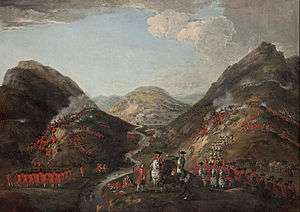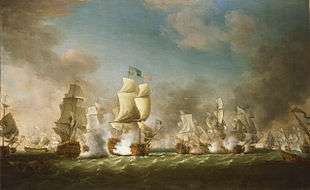War of the Quadruple Alliance
The War of the Quadruple Alliance (1718–1720) was caused by Spanish attempts to recover territorial losses agreed by the 1713 Peace of Utrecht. Primarily conducted in Italy, it included minor engagements in the Americas and Northern Europe, as well as the Spanish-backed 1719 Jacobite Rising. Spain recaptured Sardinia in 1717 without opposition, followed by a landing on Sicily in July 1718. This led to the Quadruple Alliance on 2 August 1718, comprising Britain, France, Emperor Charles VI and the Dutch Republic.
The war ended with the 1720 Treaty of The Hague; this restored the position prior to 1717 but with Savoy and Austria exchanging Sardinia and Sicily.[1] Spain regained the Kingdom of Naples during the 1733 to 1735 War of the Polish Succession.
Background

Post-1714, Spain recovered remarkably quickly from the War of the Spanish Succession, thanks to reforms initiated by chief minister Giulio Alberoni, supported by his fellow Italian Elisabeth Farnese, who became Philip V's second wife in 1714.[2] In the 1713 Peace of Utrecht, Spain ceded its possessions in Italy and Flanders to Habsburg Austria and Savoy and recovering them was a priority for the new administration of Philip V of Spain.[3]
The 1701 to 1714 war was fought to ensure neither France or the Habsburg Monarchy could ever be united with Spain but Philip now cast doubts on his renunciation of the French throne agreed at Utrecht. Charles VI of Austria also refused to formally accept this principle, as well as delaying implementation of the Dutch Barrier in the newly acquired Austrian Netherlands, an objective for which the Dutch Republic effectively bankrupted themselves. In late 1716, former opponents Britain and France agreed an Anglo-French alliance to ensure enforcement of Utrecht; in January 1717, these two and the Dutch formed the Triple Alliance.[4]
Its key principles were confirmation by Charles and Philip that they renounced their respective claims to the thrones of France and Spain, while Savoy and Austria would exchange Sicily and Sardinia. Spain saw little benefit in this and decided to seize the opportunity to recover territorial losses agreed at Utrecht. As neither Savoy nor Austria possessed significant navies, the most obvious targets were the islands of Sardinia and Sicily, an ambition that aligned with the Italian dynastic claims of Elizabeth Farnese.[5]
In August 1717, Spanish forces landed on Sardinia and by November had re-established control of the island. They met little opposition; Austria was engaged in the 1716–1718 Austro-Turkish War, while France and the Netherlands needed peace to rebuild their shattered economies.[6] Attempts to resolve the situation through diplomacy failed and in June 1718, a British naval force arrived in the Western Mediterranean as a preventive measure.[7]
Emboldened by their success in Sardinia, in July 1718 the Spanish landed 30,000 men on Sicily but the strategic position had now changed. Austria signed the July 1718 Treaty of Passarowitz with the Ottoman Empire, and on 2 August, joined Britain, France and the Dutch in the Quadruple Alliance, which gave its name to the war that followed.[8]
The war
The Spanish took Palermo on 7 July, then divided their army; on 18 July, Marquess of Lede opened the siege of Messina, while the duke of Montemar occupied the rest of the island. On 11 August, a British squadron commanded by Sir George Byng eliminated the Spanish fleet at the Battle of Cape Passaro. This was followed in the autumn by the landing of a small Austrian army, assembled in Naples by the Austrian Viceroy Count Wirich Philipp von Daun, near Messina to lift the siege by the Spanish forces. The Austrians were defeated in the First Battle of Milazzo on 15 October, and only held a small bridgehead around Milazzo.
In 1718, Cardinal Alberoni began plotting to replace the Duc d'Orléans, regent to the 5-year old King Louis XV of France, with Philip V. This plot became known as the Cellamare Conspiracy. After the plot was discovered, Alberoni was expelled from France, which declared war on Spain. By 17 December 1718, the French, British, and Austrians had all officially entered the war against Spain. The Dutch would join them later, in August 1719.
The Duc d'Orléans ordered a French army under the Duke of Berwick to invade the western Basque districts of Spain in April 1719, still under the shock of Philip V's military intervention against them. The Duke of Berwick's army met very little resistance, but was forced back by heavy losses due to disease. A second attack in Catalonia suffered the same fate.

In Sicily, the Austrians started a new offensive under Count Claude Florimond de Mercy. They first suffered a defeat in the Battle of Francavilla (20 June 1719). But the Spanish were cut off from their homeland by the British fleet and it was just a matter of time before their resistance would crumble. Mercy was then victorious in the second Battle of Milazzo, took Messina in October and besieged Palermo.
It was also in 1719 that the Irish exile, the Duke of Ormonde, organized an expedition with extensive Spanish support to invade Britain and replace King George I with James Stuart, the Jacobite "Old Pretender". However, his fleet was dispersed by a storm near Galicia in 1719, and never reached Britain. A small force of 300 Spanish marines under George Keith, tenth Earl Marischal did land near Eilean Donan, but they and the highlanders who supported them were defeated at the Battle of Eilean Donan in May 1719 and the Battle of Glen Shiel a month later, and the hopes of an uprising soon fizzled out.
In retaliation for this attack, a British fleet captured Vigo and marched inland to Pontevedra in October 1719. This caused some shock to the Spanish authorities as they realized how vulnerable they were to Allied amphibious attacks, with the potential to open up a new front away from the French frontier.
The French captured the Spanish settlement of Pensacola in Florida in May 1719, pre-empting a Spanish attack on South Carolina. While Spanish forces retook the town in August 1719, it fell to the French again towards the end of the year and they destroyed the town before withdrawing.
A 1,200 strong Spanish force set out from Cuba to take the British settlement of Nassau in the Bahamas. After taking a large amount of plunder they were eventually driven off by the local militia.
Peace
Displeased with his kingdom's military performance, Philip dismissed Alberoni in December 1719, and made peace with the allies with the Treaty of The Hague on 17 February 1720.
In the treaty, Philip was forced to relinquish all territory captured in the war. However, his third surviving son's right to the Duchy of Parma and Piacenza after the death of Isabella's childless half-cousin, Antonio Farnese, was recognized.
France returned Pensacola and the remaining conquests in the north of Spain in exchange for commercial benefits. Included in the terms of this treaty, Victor Amadeus was forced to exchange Sicily for that of the less important Kingdom of Sardinia.
Legacy
The war provided a unique example during the eighteenth century when Britain and France were on the same side. It came during a period between 1716 and 1731 when the two countries were allies. Spain would later join with France in the Bourbon Compact, and the two would become enemies of the British once more.
References
- Tucker (editor), Spencer C (2012). Almanac of American Military History; Volume I. ABC-CLIO. p. 122. ISBN 978-1598845303.CS1 maint: extra text: authors list (link)
- Rommelse, Gijs (ed), Onnekink, David (ed), Solano, Ana Crespa (author) (2011). A Change of Ideology in Imperial Spain? in Ideology and Foreign Policy in Early Modern Europe (1650–1750). Routledge. pp. 237–238. ISBN 978-1409419136.CS1 maint: multiple names: authors list (link) CS1 maint: extra text: authors list (link)
- Storrs, Ronald. "The Spanish Monarchy in the Mediterranean Theater". Yale University Blog. Retrieved 27 February 2019.
- Lesaffer, Randall. "The 18th-century Antecedents of the Concert of Europe I: The Triple Alliance of 1717". Oxford Public International Law. Retrieved 27 February 2019.
- Lesaffer, Randall. "The 18th-century Antecedents of the Concert of Europe I: The Quadruple Alliance of 1718". Oxford Public International Law. Retrieved 27 February 2019.
- Szechi, Daniel (1994). The Jacobites: Britain and Europe, 1688-1788 (First ed.). Manchester University Press. pp. 93–95. ISBN 0719037743.
- Simms, Brendan (2007). Three Victories and a Defeat: The Rise and Fall of the First British Empire, 1714-1783 (2008 ed.). Penguin. p. 135. ISBN 978-0140289848.
- Tucker (ed), Spencer, C (2009). A Global Chronology of Conflict: From the Ancient World to the Modern Middle East 6V: A Global Chronology of Conflict [6 volumes]: From the Ancient World to the Modern Middle East. ABC-CLIO. p. 724. ISBN 978-1851096671.CS1 maint: extra text: authors list (link)
Sources
- Lesaffer, Randall. "The 18th-century Antecedents of the Concert of Europe I: The Triple Alliance of 1717". Oxford Public International Law.
- Lesaffer, Randall. "The 18th-century Antecedents of the Concert of Europe I: The Quadruple Alliance of 1718". Oxford Public International Law.
- Rommelse, Gijs (ed), Onnekink, David (ed), Solano, Ana Crespa (author) (2011). A Change of Ideology in Imperial Spain? in Ideology and Foreign Policy in Early Modern Europe (1650–1750). Routledge. ISBN 978-1409419136.CS1 maint: multiple names: authors list (link) CS1 maint: extra text: authors list (link)
- Simms, Brendan (2007). Three Victories and a Defeat: The Rise and Fall of the First British Empire, 1714-1783. Penguin. ISBN 978-0140289848.
- Storrs, Ronald. "The Spanish Monarchy in the Mediterranean Theater". Yale University Blog.
- Tucker (ed), Spencer, C (2009). A Global Chronology of Conflict: From the Ancient World to the Modern Middle East 6V: A Global Chronology of Conflict [6 volumes]: From the Ancient World to the Modern Middle East. ABC-CLIO. ISBN 978-1851096671.CS1 maint: extra text: authors list (link)
